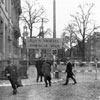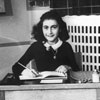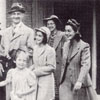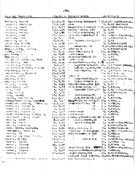Samuel Kops 
Auschwitz no. 9228 B
Samuel Kops was born to Jacob and Sara (née Zwaaf) on the 29th of July 1916 in Amsterdam. He had a brother, Joseph, who was five years younger than him.
In February 1941 his parents lived in Amsterdam at Waterlooplein 76 III. Samuel's family suffered from financial difficulties and so Samuel was placed into the care of the Dutch-Jewish orphanage for boys on the Amstell where he was raised and educated.
Following the completion of his secondary education he asked the management of the orphanage to help him to achieve his dream and to finance his medical studies. After lengthy discussions they approved the financing of his studies on condition that he would work as an educator in the orphanage itself. On the 20th of September 1942 Samuel Kops passed his final medical exam but continued to live and work in the orphanage. He was a full member of staff and his work was highly valued.
On the 27th of December 1942, on the orders of the German Appointee Dr Leitersdorf, the orphanage ceased functioning as an independent institution and was subsumed within the network of welfare institutions placed under the supervision of the German occupation authorities.
On the 5th of March 1943 the orphanage was surrounded by officers of the Amsterdam Police. The children and staff were gathered in the main playground of the orphanage. There was no way to escape. The rumour that the orphanage was surrounded and that its members were about to be deported spread throughout Amsterdam. Relatives hurried to see their children for the last time and to part from them. The police surrounded the area and when the families tried to enter the site fire-fighters became involved and the crowds were dispersed with water cannon. The SS informed the orphanage management that the deportation order concerned only the boys who were under the care of the orphanage. The manageress of the orphanage, Mrs. Hamburger, her assistant Mrs. Bing and Samuel Kops could leave and save themselves but of their own free will and in a show of dedication to their charges the three decided to attach themselves to the orphans. They found the courage and the spiritual strength to tell the Germans that they were not interested in the freedom that they had been offered and that they did not intend to abandon the 100 children of the orphanage in their hour of need. Not one of those deported that day, the children or the three staff members, survived.
On the 14th of July 1944 Samuel Kops was deported to the Transit Camp Westerbork where he was housed in barrack no. 67 in the camp – the criminals' barrack.
Less than two months later, on the 3rd of September, Samuel Kops was sent from Westerbork to Auschwitz as a Strafgeval, a term used to refer to those who were caught trying to escape or who were active in the underground.
On arrival at Auschwitz, on the 5th of September, he underwent the selection, received the number 9228 B and became an inmate of the camp.
The last mention of Kops in camp documents is from the 6th of December 1944.
Jacob and Sara Kops were murdered on the 7th of December 1942 at Auschwitz. Joseph died at the age of 22, on the 28th of February 1943, in Seibersdorf - a forced labor camp in Upper Silesia.
The Transport
On the 3rd of September 1944 an RSHA transport left the transit camp Westerbork in Holland. It contained 1,019 Jews, among them 498 men, 442 women and 79 children. They arrived at Auschwitz on the 5th of September 1944. Following the selection 258 men received the numbers 9108B – 9365B and 212 women received the numbers 25060A – 25271A and became inmates of the camp. The remainder, 549 people, were murdered immediately in the gas chambers.
Anne Frank, the famous diarist, her father Otto, mother Edith and sister Margot were also sent to Auschwitz on this transport.
Otto Frank received the number 9174B. He survived and was liberated from the camp on the 27th of January 1945. The mother, Edith, did not survive until liberation; she succumbed to exhaustion and disease in January 1945 in Auschwitz. Anne and Margot were transferred from Auschwitz to Bergen-Belsen where both perished. Margot died first, from typhus on the 31st of March, followed by her sister Anne, aged 16 at her death.
Do you have any additional information about this person? Contact Yad Vashem.





